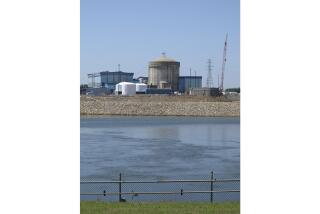Odd deterioration found in both San Onofre reactors
- Share via
Southern California Edison officials said that they are now seeing the same unusual type of wear on steam generator tubes at both of the San Onofre nuclear plant’s reactor units, which have been shuttered for months.
Officials found excessive wear in recent months on more than 300 tubes that were installed as part of the $671-million replacement of the plant’s four steam generators. The new steam generators, manufactured by Mitsubishi Heavy Industries, were installed within the last two years, which made the rate of deterioration startling.
What was even more unusual was the type of wear. U.S. Nuclear Regulatory Commission officials said the tubes in Unit 3 were vibrating excessively and rubbing against each other. Initially, they said that the wear at Unit 2 appeared to be different.
But in a statement Wednesday, Edison said that during its ongoing testing it had found additional wear in Unit 2 of a type that is “similar to the type of wear that was seen in Unit 3, but at a very low level.”
San Onofre has been out of commission since Jan. 31, when a tube in Unit 3 began leaking a small amount of radioactive steam, which brought to light the tube issues.
The NRC has prohibited the plant from firing up the reactors until the cause of the wear is understood and fixed. Commission Chairman Gregory Jaczko toured the plant last week along with Sen. Dianne Feinstein (D-Calif.) and Rep. Darrell Issa (R-Vista).
Jaczko assured reporters, anti-nuclear activists and local elected officials that the plant would remain shut down until the problems in both units are resolved.
California energy officials, meanwhile, have begun taking steps to implement contingency plans on the assumption that the plant may be down through the summer, when energy demand spikes.
A key component of the plan is temporarily bringing back online two retired generating units at the AES natural gas power plant in Huntington Beach.
Eric Pendergraft, president of plant operator AES Southland, said the company is working with regulatory agencies to make sure it has authorization to restart the units, and then will need to make some repairs, including fixing holes in the boilers and severed electrical connections. He projected the units would be back in service in about a month.
Officials are also trying to hasten transmission line upgrades, coordinating with large energy consumers like military bases, and preparing a campaign to convince consumers to conserve.
Officials have not said what they think is causing the wear. Advocacy group Friends of the Earth released a report last month arguing that design changes in the new steam generators led to the issues, and they put out a second report Thursday alleging that a series of changes made in order to add 377 more tubes to each steam generator led to the excessive vibration and degradation of the tubes.
More to Read
Sign up for Essential California
The most important California stories and recommendations in your inbox every morning.
You may occasionally receive promotional content from the Los Angeles Times.














